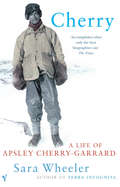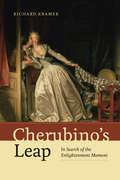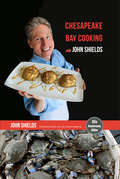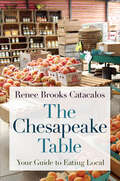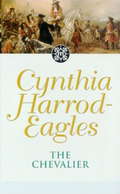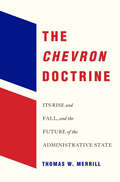- Table View
- List View
Cherokee Renascence in the New Republic (PDF)
by William G. McloughlinThe Cherokees, the most important tribe in the formative years of the American Republic, became the test case for the Founding Fathers' determination to Christianize and "civilize" all Indians and to incorporate them into the republic as full citizens. From the standpoint of the Cherokees, rather than from that of the white policymakers, William McLoughlin tells the dramatic success story of the "renascence" of the tribe. He goes on to give a full account of how the Cherokees eventually fell before the expansionism of white America and the zeal of Andrew Jackson.
Cherokee Renascence in the New Republic (PDF)
by William G. McLoughlinThe Cherokees, the most important tribe in the formative years of the American Republic, became the test case for the Founding Fathers' determination to Christianize and "civilize" all Indians and to incorporate them into the republic as full citizens. From the standpoint of the Cherokees, rather than from that of the white policymakers, William McLoughlin tells the dramatic success story of the "renascence" of the tribe. He goes on to give a full account of how the Cherokees eventually fell before the expansionism of white America and the zeal of Andrew Jackson.
Cherry: A Life of Apsley Cherry-Garrard (Modern Library Paperbacks Ser.)
by Sara WheelerApsley Cherry-Garrard (1886-1959) was one of the youngest members of Captain Scott's final expedition to the Antarctic. Cherry undertook an epic journey in the Antarctic winter to collect the eggs of the Emperor penguin. The temperature fell to seventy below, it was dark all the time, his teeth shattered in the cold and the tent blew away. 'But we kept our tempers,' Cherry wrote, 'even with God.'After serving in the First War Cherry was invalided home, and with the zealous encouragement of his neighbour Bernard Shaw he wrote a masterpiece. In The Worst Journey in the World Cherry transformed tragedy and grief into something fine. But as the years unravelled he faced a terrible struggle against depression, breakdown and despair, haunted by the possibility that he could have saved Scott and his companions. This is the first biography of Cherry. Sara Wheeler, who has travelled extensively in the Antarctic, has had unrestricted access to new material and the full co-operation of Cherry's family.
'Cherry' Ingram: The Englishman Who Saved Japan’s Blossoms
by Naoko AbeThe irresistible story of Japanese cherry blossoms, threatened by political ideology and saved by an unknown EnglishmanCollingwood Ingram, known as ‘Cherry’ for his defining obsession, was born in 1880 and lived until he was a hundred, witnessing a fraught century of conflict and change. After visiting Japan in 1902 and 1907 and discovering two magnificent cherry trees in the garden of his family home in Kent in 1919, Ingram fell in love with cherry blossoms, or sakura, and dedicated much of his life to their cultivation and preservation.On a 1926 trip to Japan to search for new specimens, Ingram was shocked to see the loss of local cherry diversity, driven by modernisation, neglect and a dangerous and creeping ideology. A cloned cherry, the Somei-yoshino, was taking over the landscape and becoming the symbol of Japan's expansionist ambitions.The most striking absence from the Japanese cherry scene, for Ingram, was that of Taihaku, a brilliant ‘great white’ cherry tree. A proud example of this tree grew in his English garden and he swore to return it to its native home. Multiple attempts to send Taihaku scions back to Japan ended in failure, but Ingram persisted.Over decades, Ingram became one of the world’s leading cherry experts and shared the joy of sakura both nationally and internationally. Every spring we enjoy his legacy. ‘Cherry’ Ingram is a portrait of this little-known Englishman, a story of Britain and Japan in the twentieth century and an exploration of the delicate blossoms whose beauty is admired around the world.
Cherry Red, Cherry Black: The Story of Coffee in India
by Kavery NambisanWhat is coffee's origin story? When and how did coffee reach India? When did plantations come into being? How did the beverage take root in the culture? How did it become so popular? Cherry Red, Cherry Black tells an enjoyably informative story of coffee in India starting at the very beginning and working its way to the present. With a storyteller's flair Kavery Nambisan sets the scene with the history of the origins of coffee, its serendipitous entry into India, early planting by village communities of the Mysore and Malabar provinces and the foray of British who scented commercial gains and began large scale plantations. In 1922, the plantations amalgamated into the Consolidated Coffee Estates. In 1990, it was acquired by the Tata Group to become Tata Coffee, the only corporate venture that deals with coffee from cultivation to processing, curing, packaging, sales and retail. Cherry Red, Cherry Black features profiles of major players in the field including some on experts who work as coffee tasters, while also the listing the varied and delectable ways of making and drinking coffee.
Cherubino's Leap: In Search of the Enlightenment Moment
by Richard KramerFor the Enlightenment mind, from Moses Mendelssohn’s focus on the moment of surprise at the heart of the work of art to Herder’s imagining of the seismic moment at which language was discovered, it is the flash of recognition that nails the essence of the work, the blink of an eye in which one’s world changes. In Cherubino’s Leap, Richard Kramer unmasks such prismatic moments in iconic music from the Enlightenment, from the “chromatic” moment—the single tone that disturbs the thrust of a diatonic musical discourse—and its deployment in seminal instrumental works by Emanuel Bach, Haydn, and Mozart; on to the poetic moment, taking the odes of Klopstock, in their finely wrought prosody, as a challenge to the problem of strophic song; and finally to the grand stage of opera, to the intense moment of recognition in Gluck’s Iphigénie en Tauride and the exquisitely introverted phrase that complicates Cherubino’s daring moment of escape in Mozart’s Figaro. Finally, the tears of the disconsolate Konstanze in Mozart’s Die Entführung aus dem Serail provoke a reflection on the tragic aspect of Mozart’s operatic women. Throughout, other players from literature and the arts—Diderot, Goethe, Lessing among them—enrich the landscape of this bold journey through the Enlightenment imagination.
Cherubino's Leap: In Search of the Enlightenment Moment
by Richard KramerFor the Enlightenment mind, from Moses Mendelssohn’s focus on the moment of surprise at the heart of the work of art to Herder’s imagining of the seismic moment at which language was discovered, it is the flash of recognition that nails the essence of the work, the blink of an eye in which one’s world changes. In Cherubino’s Leap, Richard Kramer unmasks such prismatic moments in iconic music from the Enlightenment, from the “chromatic” moment—the single tone that disturbs the thrust of a diatonic musical discourse—and its deployment in seminal instrumental works by Emanuel Bach, Haydn, and Mozart; on to the poetic moment, taking the odes of Klopstock, in their finely wrought prosody, as a challenge to the problem of strophic song; and finally to the grand stage of opera, to the intense moment of recognition in Gluck’s Iphigénie en Tauride and the exquisitely introverted phrase that complicates Cherubino’s daring moment of escape in Mozart’s Figaro. Finally, the tears of the disconsolate Konstanze in Mozart’s Die Entführung aus dem Serail provoke a reflection on the tragic aspect of Mozart’s operatic women. Throughout, other players from literature and the arts—Diderot, Goethe, Lessing among them—enrich the landscape of this bold journey through the Enlightenment imagination.
Cherubino's Leap: In Search of the Enlightenment Moment
by Richard KramerFor the Enlightenment mind, from Moses Mendelssohn’s focus on the moment of surprise at the heart of the work of art to Herder’s imagining of the seismic moment at which language was discovered, it is the flash of recognition that nails the essence of the work, the blink of an eye in which one’s world changes. In Cherubino’s Leap, Richard Kramer unmasks such prismatic moments in iconic music from the Enlightenment, from the “chromatic” moment—the single tone that disturbs the thrust of a diatonic musical discourse—and its deployment in seminal instrumental works by Emanuel Bach, Haydn, and Mozart; on to the poetic moment, taking the odes of Klopstock, in their finely wrought prosody, as a challenge to the problem of strophic song; and finally to the grand stage of opera, to the intense moment of recognition in Gluck’s Iphigénie en Tauride and the exquisitely introverted phrase that complicates Cherubino’s daring moment of escape in Mozart’s Figaro. Finally, the tears of the disconsolate Konstanze in Mozart’s Die Entführung aus dem Serail provoke a reflection on the tragic aspect of Mozart’s operatic women. Throughout, other players from literature and the arts—Diderot, Goethe, Lessing among them—enrich the landscape of this bold journey through the Enlightenment imagination.
Cherubino's Leap: In Search of the Enlightenment Moment
by Richard KramerFor the Enlightenment mind, from Moses Mendelssohn’s focus on the moment of surprise at the heart of the work of art to Herder’s imagining of the seismic moment at which language was discovered, it is the flash of recognition that nails the essence of the work, the blink of an eye in which one’s world changes. In Cherubino’s Leap, Richard Kramer unmasks such prismatic moments in iconic music from the Enlightenment, from the “chromatic” moment—the single tone that disturbs the thrust of a diatonic musical discourse—and its deployment in seminal instrumental works by Emanuel Bach, Haydn, and Mozart; on to the poetic moment, taking the odes of Klopstock, in their finely wrought prosody, as a challenge to the problem of strophic song; and finally to the grand stage of opera, to the intense moment of recognition in Gluck’s Iphigénie en Tauride and the exquisitely introverted phrase that complicates Cherubino’s daring moment of escape in Mozart’s Figaro. Finally, the tears of the disconsolate Konstanze in Mozart’s Die Entführung aus dem Serail provoke a reflection on the tragic aspect of Mozart’s operatic women. Throughout, other players from literature and the arts—Diderot, Goethe, Lessing among them—enrich the landscape of this bold journey through the Enlightenment imagination.
The Cherwell School: The First Fifty Years 1963–2013
by Martin RobertsOriginally among the smallest secondary schools in Oxford, and without much of a reputation, by 2013 The Cherwell School had grown fourfold and established a national reputation for quality. Martin Roberts tells the story of this remarkable change, recalling key events and personalities along the way. Featuring artwork and photography from pupils and staff, this book will bring back memories to all those who have contributed to the first fifty years of The Cherwell School.
The Cherwell School: The First Fifty Years 1963–2013
by Martin RobertsOriginally among the smallest secondary schools in Oxford, and without much of a reputation, by 2013 The Cherwell School had grown fourfold and established a national reputation for quality. Andrew Roberts tells the story of this remarkable change, recalling key events and personalities along the way. Featuring artwork and photography from pupils and staff, this book will bring back memories to all those who have contributed to the first fifty years of The Cherwell School.
Chesapeake Bay Cooking with John Shields
by John ShieldsTwenty-five years ago, Chesapeake Bay Cooking with John Shields introduced the world to the regional cuisine of the Mid-Atlantic. Nominated for a James Beard Award, the book was praised for its inspiring heritage recipes and its then-revolutionary emphasis on cooking with local and seasonal ingredients. Part history lesson, part travelogue, the book captured the unique character of the Chesapeake region and its people.In this anniversary edition, John Shields combines popular classic dishes with a host of unpublished recipes from his personal archives. Readers will learn how to prepare over 200 recipes from the Mid-Atlantic region, including panfried rockfish, roast mallard, beaten biscuits, oyster fritters, and Lady Baltimore cake. Best of all, they’ll learn everything they need to know about crabsâ€�the undisputed star of Chesapeake cuisineâ€�featured here in mouthwatering recipes for seven different kinds of crab cakes.Extensively updated, this edition includes a new chapter on Chesapeake libations, which features Shields’s closely held recipe for his notorious Dirty Gertie, an authentic Chesapeake-style Bloody Mary.
The Chesapeake Campaigns 1813–15: Middle ground of the War of 1812 (Campaign #259)
by Graham Turner Scott S. SheadsThe War of 1812 was never the most popular of conflicts on both sides of the Atlantic. Bogged down by their involvement in the Napoleonic conflict in Europe, the British largely relied on the power of the Royal Navy in the early years of the war. Part of this naval strategy was to blockade the American coastline in order to strangle American commerce and bring the new nation to its knees. Nowhere was this blockade more important than in the Chesapeake. Partly in response to the sacking of York (modern Toronto), the British decided to strike at the nation's capital, Washington, DC, and a force of Peninsular War veterans under General Robert Ross landed, defeated the Americans at the battle of Bladensburg and took Washington on August 24, 1814. Buoyed by this success, the British pressed on towards Baltimore. However, they were forced to withdraw at the battle of North Point, and a naval bombardment of Fort McHenry failed to reduce the fort and Baltimore was spared. With his intimate knowledge of the events in this theatre of war, Scott Sheads of Fort McHenry NPS brings these dramatic events of American history to life.
The Chesapeake Campaigns 1813–15: Middle ground of the War of 1812 (Campaign #259)
by Graham Turner Scott S. SheadsThe War of 1812 was never the most popular of conflicts on both sides of the Atlantic. Bogged down by their involvement in the Napoleonic conflict in Europe, the British largely relied on the power of the Royal Navy in the early years of the war. Part of this naval strategy was to blockade the American coastline in order to strangle American commerce and bring the new nation to its knees. Nowhere was this blockade more important than in the Chesapeake. Partly in response to the sacking of York (modern Toronto), the British decided to strike at the nation's capital, Washington, DC, and a force of Peninsular War veterans under General Robert Ross landed, defeated the Americans at the battle of Bladensburg and took Washington on August 24, 1814. Buoyed by this success, the British pressed on towards Baltimore. However, they were forced to withdraw at the battle of North Point, and a naval bombardment of Fort McHenry failed to reduce the fort and Baltimore was spared. With his intimate knowledge of the events in this theatre of war, Scott Sheads of Fort McHenry NPS brings these dramatic events of American history to life.
The Chesapeake Table: Your Guide to Eating Local
by Renee Brooks CatacalosThere was a time when most food was local, whether you lived on a farm or bought your food at a farmers market in the city. Exotic foods like olives, spices, and chocolate shipped in from other parts of the world were considered luxuries. Now, most food that Americans eat is shipped from somewhere else, and eating local is considered by some to be a luxury. Renee Brooks Catacalos is here to remind us that eating local is easier;¢;‚¬;€?and more rewarding;¢;‚¬;€?than we may think. There is an abundance of food all around us, found across the acres and acres of fields and pastures, orchards and forests, mile upon winding mile of rivers and streams, ocean coastline, and the amazing Chesapeake Bay.In The Chesapeake Table, Catacalos examines the powerful effect of eating local in Maryland, Virginia, and Washington, DC. Hooked on the local food movement from its early days, Catacalos opens the book by revisiting a personal challenge to only buy, prepare, and eat food grown within a 150-mile radius of her home near Washington, DC. From her in-depth, on-the-ground study of food systems in the region, Catacalos offers practical advice for adopting a locavore diet and getting involved in various entry points to food pathways, from shopping at your local farmers market to buying a community-supported agriculture share. She also includes recipes for those curious about how they can make their own more environmentally conscious food choices.Introducing readers to the vast edible resources of the Chesapeake region, Catacalos focuses on the challenges of environmental and economic sustainability, equity and diversity in the farming and food professions, and access and inclusion for local consumers of all income levels, ethnicities, and geographies. Touching on everything from farm-based breweries and distilleries to urban hoop house farms to grass-fed beef, The Chesapeake Table celebrates the people working hard to put great local food on our plates.
The Chesapeake Table: Your Guide to Eating Local
by Renee Brooks CatacalosThere was a time when most food was local, whether you lived on a farm or bought your food at a farmers market in the city. Exotic foods like olives, spices, and chocolate shipped in from other parts of the world were considered luxuries. Now, most food that Americans eat is shipped from somewhere else, and eating local is considered by some to be a luxury. Renee Brooks Catacalos is here to remind us that eating local is easier;¢;‚¬;€?and more rewarding;¢;‚¬;€?than we may think. There is an abundance of food all around us, found across the acres and acres of fields and pastures, orchards and forests, mile upon winding mile of rivers and streams, ocean coastline, and the amazing Chesapeake Bay.In The Chesapeake Table, Catacalos examines the powerful effect of eating local in Maryland, Virginia, and Washington, DC. Hooked on the local food movement from its early days, Catacalos opens the book by revisiting a personal challenge to only buy, prepare, and eat food grown within a 150-mile radius of her home near Washington, DC. From her in-depth, on-the-ground study of food systems in the region, Catacalos offers practical advice for adopting a locavore diet and getting involved in various entry points to food pathways, from shopping at your local farmers market to buying a community-supported agriculture share. She also includes recipes for those curious about how they can make their own more environmentally conscious food choices.Introducing readers to the vast edible resources of the Chesapeake region, Catacalos focuses on the challenges of environmental and economic sustainability, equity and diversity in the farming and food professions, and access and inclusion for local consumers of all income levels, ethnicities, and geographies. Touching on everything from farm-based breweries and distilleries to urban hoop house farms to grass-fed beef, The Chesapeake Table celebrates the people working hard to put great local food on our plates.
Cheshire Folk Tales
by Johnny GillettThese lively and entertaining folk tales from one of Britain's most ancient counties are vividly retold by local storyteller The Journey Man. Their origins lost in the oral tradition, these thirty stories from Cheshire reflect the wisdom (and eccentricities) of the county and its people. Cheshire has a rich and diverse collection of tales, from the stories of some of Britain’s most famous mythical heroes, to tales of demons, dragons, boggarts and sniddlebogs. These stories, illustrated with twenty-five line drawings, bring alive the landscape of the county’s rolling hills and fertile plains. The Journey Man is a professional storyteller who has been telling stories across the world for over twenty years.
The Chessboard and the Web: Strategies of Connection in a Networked World (The Henry L. Stimson Lectures Series)
by Anne-Marie SlaughterFrom a renowned foreign-policy expert, a new paradigm for strategy in the twenty-first century In 1961, Thomas Schelling’s The Strategy of Conflict used game theory to radically reenvision the U.S.-Soviet relationship and establish the basis of international relations for the rest of the Cold War. Now, Anne-Marie Slaughter—one of Foreign Policy’s Top 100 Global Thinkers from 2009 to 2012, and the first woman to serve as director of the State Department Office of Policy Planning—applies network theory to develop a new set of strategies for the post-Cold War world. While chessboard-style competitive relationships still exist—U.S.-Iranian relations, for example—many other situations demand that we look not at individual entities but at their links to one another. We must learn to understand, shape, and build on those connections. Concise and accessible, based on real-world situations, on a lucid understanding of network science, and on a clear taxonomy of strategies, this will be a go-to resource for anyone looking for a new way to think about strategy in politics or business.
Chester I. Barnard: Innovator of Organization Theory
by Kazuhito IsomuraThis book looks at Chester I. Barnard’s theoretical and practical contributions to organization theory by examining his life, career, experience, intellectual relationships, philosophy, method, and theory.Barnard (1886–1961) is considered an innovator in the field with the publication of his seminal work, The Functions of the Executive, in 1938. But why was Barnard able to publish such a groundbreaking book despite the fact that he was a practitioner, not an academic researcher? In pursuit of that question, this book carefully investigates the background of his ideas about management, such as his experience, philosophy, and method. It then traces the process of how Barnard built his concepts of organization as it examines his books, published papers, unpublished manuscripts, and correspondence and systematically summarizes how he built his theory of organization and management. Finally, the author explores how Barnard’s theory has the potential to be developed and put into practice by examining his important works after his publication of The Functions of the Executive, which is well known as abstract and difficult. Readers of this present book will come away with a clearer and more systematic understanding of Barnard’s theoretical and practical contributions to the field.
The Chetnik Movement and the Yugoslav Resistance
by Matteo J. MilazzoThis book fills a gap in the historical knowledge of wartime Yugoslavia. Focusing on the Chetnik movement provides a better understanding of the various ways that important segments of the population, including members of the Yugoslav officer corps and Serb civilians, perceived and responded to the occupation. The partisans' ultimate success does not conceal the fact that during the greater part of the war, several armed groups, owing at least some sort of allegiance to Mihailovic, chose very different courses of resistance. The overriding question for Milazzo is how a movement whose leadership was in no sense pro-Axis found itself progressively drawn into a hopelessly compromising set of relationships with the occupation authorities and the Quisling regime. What was it about the situation in occupied Yugoslavia and the Serb officers' response to that state of affairs that prevented them from carrying out serious anti-Axis activity or engaging in effective collaboration? The author attends to the emergence, organization, and failure of the Chetniks, the regional particularities of the movement, and Mihailovic's efforts to establish his own authority over the widely scattered non-Communist armed formations. The author also discusses the domestic opposition to Tito and the complex reality of the national and political civil war in Yugoslavia.
The Chetnik Movement and the Yugoslav Resistance
by Matteo J. MilazzoThis book fills a gap in the historical knowledge of wartime Yugoslavia. Focusing on the Chetnik movement provides a better understanding of the various ways that important segments of the population, including members of the Yugoslav officer corps and Serb civilians, perceived and responded to the occupation. The partisans' ultimate success does not conceal the fact that during the greater part of the war, several armed groups, owing at least some sort of allegiance to Mihailovic, chose very different courses of resistance. The overriding question for Milazzo is how a movement whose leadership was in no sense pro-Axis found itself progressively drawn into a hopelessly compromising set of relationships with the occupation authorities and the Quisling regime. What was it about the situation in occupied Yugoslavia and the Serb officers' response to that state of affairs that prevented them from carrying out serious anti-Axis activity or engaging in effective collaboration? The author attends to the emergence, organization, and failure of the Chetniks, the regional particularities of the movement, and Mihailovic's efforts to establish his own authority over the widely scattered non-Communist armed formations. The author also discusses the domestic opposition to Tito and the complex reality of the national and political civil war in Yugoslavia.
The Chevalier: The Morland Dynasty, Book 7 (Morland Dynasty #7)
by Cynthia Harrod-Eagles1689: the Resoration enabled the Morland family to restore their own fortune, but now the Jacobite rebellion brings another threat to their security.Annuciata Morland, fiercely loyal to the Stuart cause, follows her beloved king, James II, into exile. She leaves her gentle grandson, Matt, to oversee Morland Place in her absence. Without her wise presence, Matt finds himself in an arranged marriage to India Neville and at the mercy of a woman as heartless as she is beautiful. After a lonely and sheltered life he lurches between the exquisite pain of love and the torment of deep despair.When James III - the Chevalier - returns to claim the Stuart throne, the Morlands are reunited in one country. Death and defeat threaten them, but their loves and loyalty prove stronger than kingly ambitions.
The Chevalier d'Eon and his Worlds: Gender, Espionage and Politics in the Eighteenth Century
by Simon BurrowsCross-dressing author, envoy, soldier and spy Charles d'Eon de Beaumont's unusual career fascinated his contemporaries and continues to attract historians, novelists, playwrights, filmmakers, image makers, cultural theorists and those concerned with manifestations of the extraordinary. D'Eon's significance as a historical figure was already being debated more than 45 years before his death. Not surprisingly, such sensational material has attracted the attention of enthusiasts, scholars and literateurs to 'the strange case of the chevalier d'Eon'. He has also attracted the attention of psychologists and sexologists, and for most of the last century his gender transformation has been viewed through a Freudian lens. His cross-dressing, it was usually assumed, must have a psychosexual explanation. Until the second half of the twentieth century the terms 'Eonist' and 'Eonism' were the standard English words for transvestites and transvestism respectively, but 'Eonism' was also, thanks to Havelock Ellis, widely regarded as a psychological condition or compulsion. However, in the mid-twentieth century, new ideas about gender-identity disorders led to d'Eon being redefined not as a transvestite, but a transsexual - a person who considers their sex to have been 'misassigned'. The essays in this collection contribute to d'Eon's rehabilitation as a figure worthy of scholarly attention and display a variety of disciplinary approaches. Drawing on new research into d'Eon's life, this volume offers original and nuanced readings of how a gender identity could come to be negotiated over time.
The Chevalier d'Eon and his Worlds: Gender, Espionage and Politics in the Eighteenth Century
by Simon Burrows Jonathan Conlin Russell Goulbourne Valerie MainzCross-dressing author, envoy, soldier and spy Charles d'Eon de Beaumont's unusual career fascinated his contemporaries and continues to attract historians, novelists, playwrights, filmmakers, image makers, cultural theorists and those concerned with manifestations of the extraordinary. D'Eon's significance as a historical figure was already being debated more than 45 years before his death. Â Not surprisingly, such sensational material has attracted the attention of enthusiasts, scholars and literateurs to 'the strange case of the chevalier d'Eon'. He has also attracted the attention of psychologists and sexologists, and for most of the last century his gender transformation has been viewed through a Freudian lens. His cross-dressing, it was usually assumed, must have a psychosexual explanation. Until the second half of the twentieth century the terms 'Eonist' and 'Eonism' were the standard English words for transvestites and transvestism respectively, but 'Eonism' was also, thanks to Havelock Ellis, widely regarded as a psychological condition or compulsion. However, in the mid-twentieth century, new ideas about gender-identity disorders led to d'Eon being redefined not as a transvestite, but a transsexual - a person who considers their sex to have been 'misassigned'. Â Â The essays in this collection contribute to d'Eon's rehabilitation as a figure worthy of scholarly attention and display a variety of disciplinary approaches. Drawing on new research into d'Eon's life, this volume offers original and nuanced readings of how a gender identity could come to be negotiated over time.Â
The Chevron Doctrine: Its Rise and Fall, and the Future of the Administrative State
by Thomas W. MerrillA leading expert on the administrative state describes the past, present, and future of the immensely consequential—and equally controversial—legal doctrine that has come to define how Congress’s laws are applied by the executive branch. The Constitution makes Congress the principal federal lawmaker. But for a variety of reasons, including partisan gridlock, Congress increasingly fails to keep up with the challenges facing our society. Power has inevitably shifted to the executive branch agencies that interpret laws already on the books and to the courts that review the agencies’ interpretations. Since the Supreme Court’s 1984 decision in Chevron v. Natural Resources Defense Council, this judicial review has been highly deferential: courts must uphold agency interpretations of unclear laws as long as these interpretations are “reasonable.” But the Chevron doctrine faces backlash from constitutional scholars and, now, from Supreme Court justices who insist that courts, not administrative agencies, have the authority to say what the law is. Critics of the administrative state also charge that Chevron deference enables unaccountable bureaucratic power. Thomas Merrill reviews the history and immense consequences of the Chevron doctrine and suggests a way forward. Recognizing that Congress cannot help relying on agencies to carry out laws, Merrill rejects the notion of discarding the administrative state. Instead, he focuses on what should be the proper relationship between agencies and courts in interpreting laws, given the strengths and weaknesses of these institutions. Courts are better at enforcing the rule of law and constitutional values; agencies have more policy expertise and receive more public input. And, unlike courts, agencies are subject to at least some political discipline. The best solution, Merrill suggests, is not of the either-or variety. Neither executive agencies nor courts alone should pick up the slack of our increasingly ineffectual legislature.

